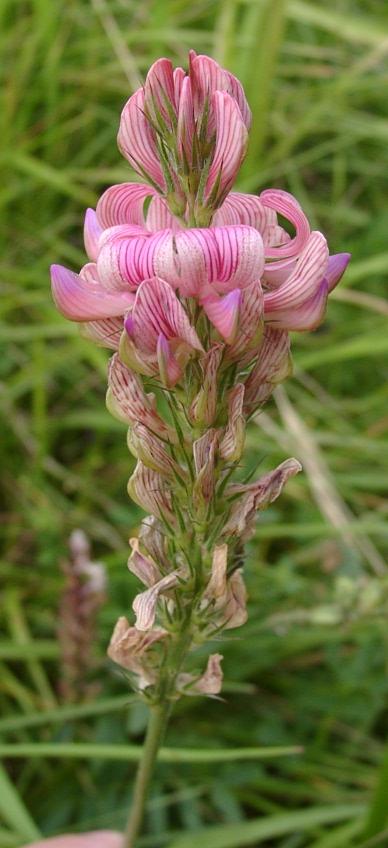- Sainfoin
Taxobox
name = Sainfoin

image_width = 200px
image_caption = "Onobrychis viciifolia"
regnum =Plant ae
divisio = Magnoliophyta
classis = Magnoliopsida
ordo =Fabales
familia =Fabaceae
subfamilia =Faboideae
tribus =Hedysareae
genus = "Onobrychis"Sainfoins ("Onobrychis") are Eurasian perennial
herb s that have pale pink flowers and round single-seeded pods (see image below). "O. viciifolia" is naturalized throughout many countries inEurope andNorth America grassland s oncalcareous soil s. TheFlora Europaea lists 23 species of "Onobrychis".This highly nutritious
plant was an important forage for heavy working horses inagriculture and a good source of nectar forhoney bees in Britain. Because the plant is rich intannins which protectprotein s fromhydrolysis in therumen , the proteins are instead absorbed in theabomasum . The plant has a deeptaproot and so is verydrought-resistant , but does not recover well from grazing.Sainfoin is difficult to establish, only yields one crop per year and is not persistent in grassland so is seldom grown in any significant acreage.* Flowers: June-September.
* Distribution: grassland, cultivated land, waste places in throughoutEurope as far north as southernSweden .
* Leaves:pinnate , alternate, 6 to 14 pairs, oblong to linear.A species, "
Onobrychis caput-galli ", is known as the "Cock's Head" in English (cf. Latin "caput galli")."Onobrychis" species are used as food plants by the
larva e of someLepidoptera (butterfly andmoth ) species including "Coleophora colutella" (recorded on "O. saxatilis").Etymology
"Sainfoin" comes from French "sain foin": sane hay.
"XVIe s.— L'herbe appellée en France sain-foin, en Italie herba medica, en Provence et Languedoc luzerne. De l'excessive louange qu'on a donné à ceste plante, à cause de sa vertu medecinale et engraissante le bestail qui s'en paist, vient ce mot de sain (O. de Serres)"
"Onobrychis" comes from Greek "onos" (ass) and "brycho" (to eat greedily), referring to its properties as a forage plant.
Wikimedia Foundation. 2010.
